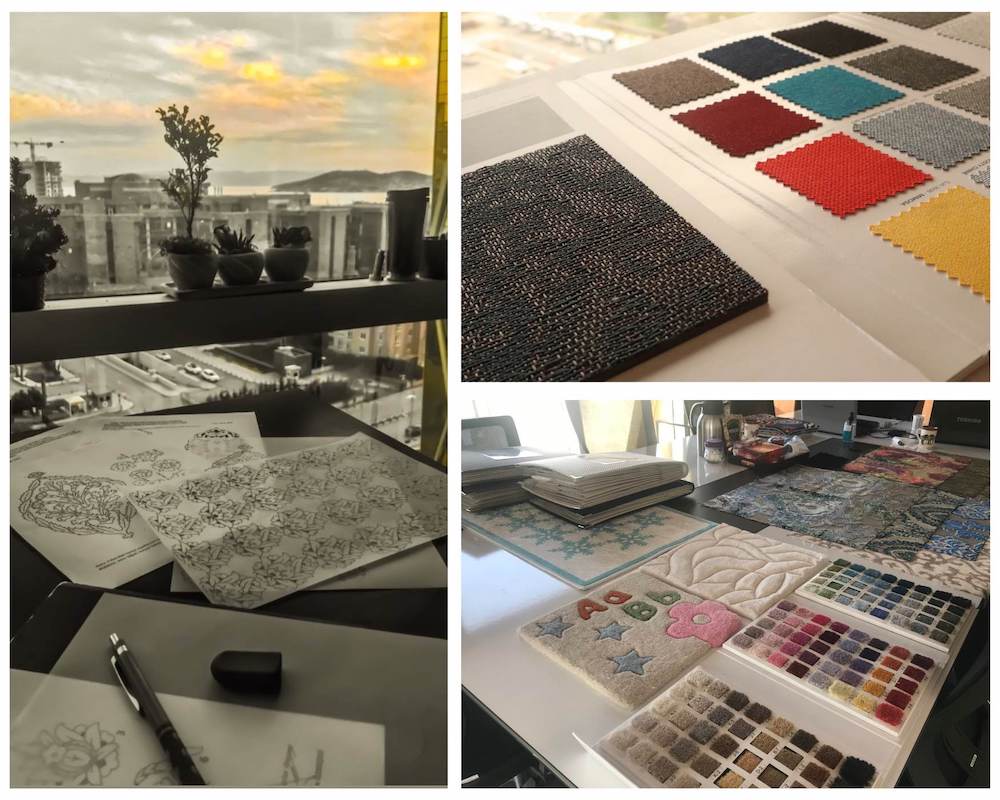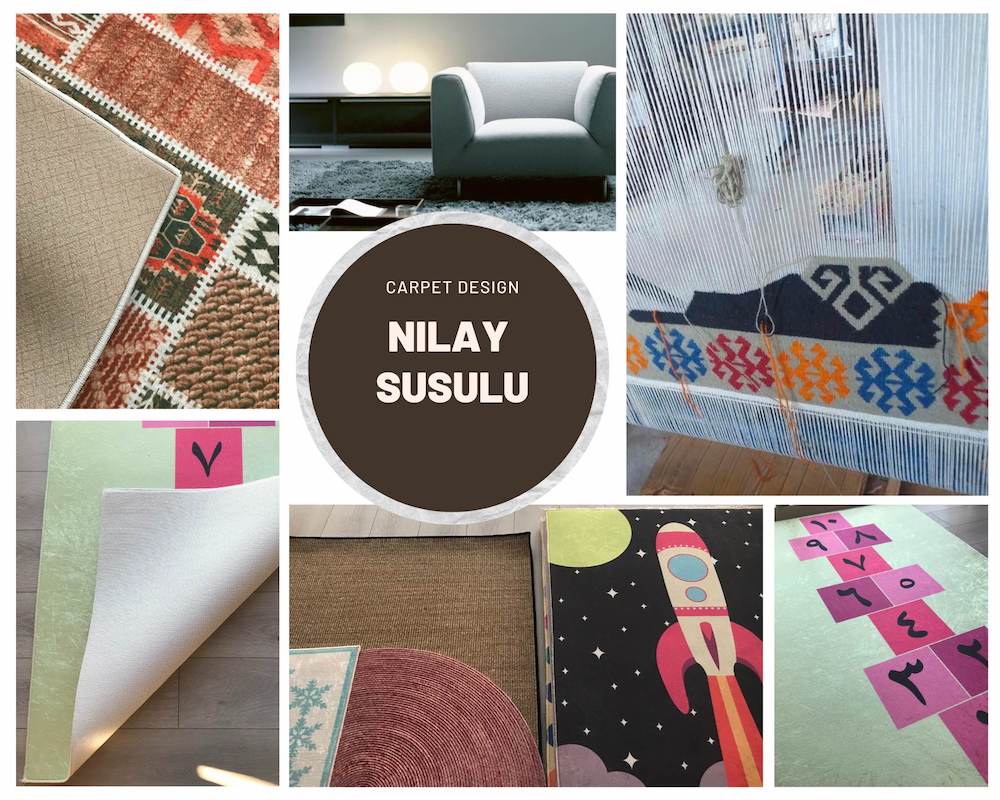Interview with Mrs Nilay Susulu – Designer & Creative Producer
I was born in Istanbul in 1987. I studied home textile design in high school and started designing in my high school years by drawing patterns for bridal boutiques and brode factories. I studied Fashion and Textile Design at Balıkesir University and Cinema at Istanbul University.
1- First, please let us know a bit about your biography and your experience in the carpet industry and carpet design.
I am currently pursuing my master’s degree at Yıldız Technical University, Department of Turkish Arts Design with a thesis. My freelance design work, which I started in high school, continued during my university years. I did my university internship by designing accessories for Faruk Saraç’s collections. As of today, I have been serving the carpet and home textile industry for 18 years.
I worked as a design manager at Dinarsu Carpet. In 2017, I left Dinarsu Carpet and founded my own company. My client portfolio, which I have known in multinational companies where I have worked for years, started to work with me as soon as they heard of my independence. This customer portfolio is the biggest reason for me to take quick steps in the field of export. I am involved in many hotel, yacht, office, and home projects. Design Life Magazine from Turkey, Wautier Carpet from Australia, and Marine Leather from Italy are the companies that I have partnered with.
We design and organize the production of carpet, fabric and leather products. Apart from being a brand supporter, I established my brands MAISO’NS, MAISO’NS FAIT MAIN and LIMAJUNO HOME. We are producing export-oriented boutiques.
2- How do you evaluate machine made carpet sector in Turkey in general?
The machine-made carpet industry in Turkey developed very rapidly after the 1960s with the effect of technology. It continues to develop. The world carpet market counts on Turkey as a contract manufacturer until recently, but with export breakthroughs in recent years, Turkey now addressing the creative global world in Turkish carpet design and we are the leader in design.
The production conditions in the domestic market had a serious turnover even during the pandemic period. This means that carpet, which is one of Turkish traditional culture, did not fall short of its full efficiency service to every point of our living spaces.
The Turkish carpet industry first takes its strength from the centuries-old history of art and culture and serves in the country. With the aura, we get from our own country and our citizens, it spreads freely to the world with its own colors.
3- What is special about Turkish carpet design and designers?
As I just mentioned, our centuries-old culture is our biggest source of inspiration.
Turkish Culture is one of the oldest in the world. Our ancestors dominated many continents for centuries. They lived in common with many world cultures. This inevitably creates a cultural network. Adds unique values to its structure.
Belonging to such a culture makes Turkish Designers unique along with our spirituality. Many people from all over the world find a piece of their own culture and essence in every piece of work created by Turkish designers.
As of 2023, in the global design world, we will hear the names of Modern Turkish Designers more and more. The year 2023 will be the year when Turkish Designers, powered by their centuries-old past, will reach their peak in the postmodern line.
4- How do you draw a new and creative carpet design suitable for the market?
First of all, our only technically unchanged rule is manufacturability. When we say manufacturability, it means that the composition mathematics of all the materials of the carpet design is well settled. Balance is very important in design. Color balance and material diversity balance should all be considered in detail but should be used as a whole.
The style of the pattern should add integrity to the quality of the yarns. You cannot show the classic very dense patterns with thick fibers. If you give practice of collapsing to patterns intensely, you will destroy the perception of integrity. Creativity does not mean drawing attention by doing the untested boldly. It is often possible to make creative designs by blending natural lines with fashion and trendy colors.
5- what is the differences between carpet design for the domestic market, and designs for the international export market?
Patterns adorned with their own cultural colors and motifs are indispensable for domestic market designs, not only for Turkey, but for all countries.
Export companies do not go beyond natural fibers and colors. I can tell the best example with Sisal carpets. Sisal equivalent carpets in the Turkish market are adorned with various accessories produced in traditional colors. Sisal carpets in the export channel certainly do not go beyond the texture of soil and wood.
6- Many students are interested in being professional carpet designer, how we can be a creative carpet designer?
– The person concerned should definitely train himself in his field,
– Should index his life and ideas to the global design world,
– Be open to criticism, be able to make constructive criticism,
– Must follow and adapt to technology,
– Should be interested in art and history and travel for cultural studies,
-Follow and participate in professional organizations.
-Not too much, it should work in a balanced and planned way.
7- What is the difference between carpet design for tufting carpets, digitally printed carpets and machine-made carpets?
Tufting carpet is a carpet technique that weaves the carpet on a tensioner of any size with a gun (hand tuft) or machine (Auto tuft). Yarns such as wool, viscose, and Tencel are preferred in tufting carpet textures. Yacht carpets, hotel carpets, and home carpets are produced by tufting weaving and boutique productions. offers daily solutions. Tencel yarn is generally used in yacht carpets due to its recycling and water-repellent properties.
Digitally printed carpets are produced by printing on pile carpets and fabrics. The plain white woven pile carpet is printed with a million-colour quality spray method. In the fabric-to-carpet printing (transfer print carpet) method, the pattern is first printed on paper. The six non-slip bases is placed on the fabric and passed through the press. They are subjected to the garment process according to size.
The machine-made carpet technique is also launched with the name of the machine. Carpet weaving machines like Vandewiele can be produced in maximum 8 colours. Fibres such as acrylic, viscose, and polyester are used in weaving.
8- What are the copywriting terms and conditions rules in Turkey? Is it enough to protect your idea and designs? How is the process of registering your carpet designs in Turkey?
In Turkey, each brand acts in line with its own lines in terms of patents and rights. I think the situation in the foreign market is legally sufficient within the borders of the domestic market, and the situation in the foreign market shows some flexibility. In this case, I have the feeling that international patent institutions will be insufficient.
The registration process in Turkey is evaluated from a general table, such as the originality of the design and its non-similarity. In companies with high production capacity, it is done with each collection work. Each pattern is registered with its designer.
9- please add other information to the interview if you like
Carpet is my love, my passion that contains all the meaning of my life that I cannot give up no matter what I do.
All my sectoral initiatives so far are steps taken to add value to the carpet community.
Accordingly, I would like to tell you about my education and art initiatives other than design.
As Art Design Academy Turkey, which I am the founder of, we have created a school in Turkey with our education model. We have created a never-ending education platform with all our design-related students by doing something that has never been done before, with tailor-made and corporate-specific training, the materials we share and the opportunities we offer.
In 2023, we are signing important project partnerships with foreign software companies. In this way, each of our students will be able to practice their profession outside the borders of Turkey. Our only requirement for registration is to be at least a high school graduate.
Another initiative we have put into practice in 2023 is our brand promotion films and documentary works.
Due to my job, I travel frequently in and out of the country. In every city I’m in for business, we shoot documentaries about the carpet and rug culture and traditional arts. I started my brand film work by shooting the films of my own brands.






















